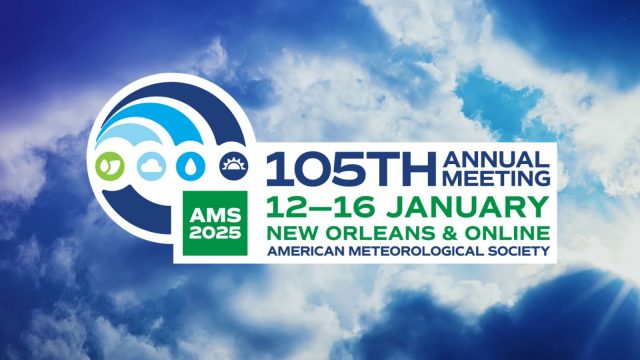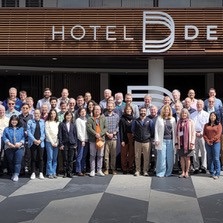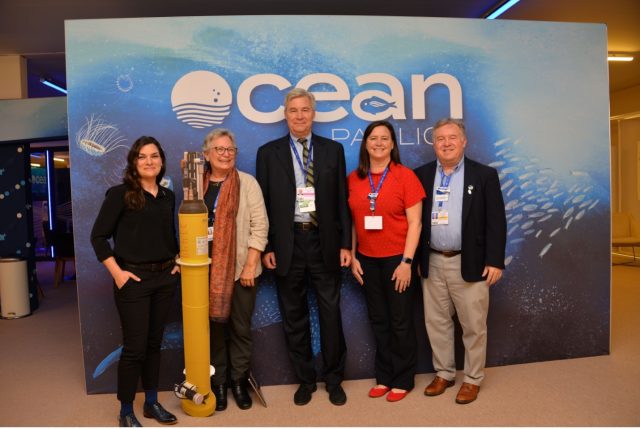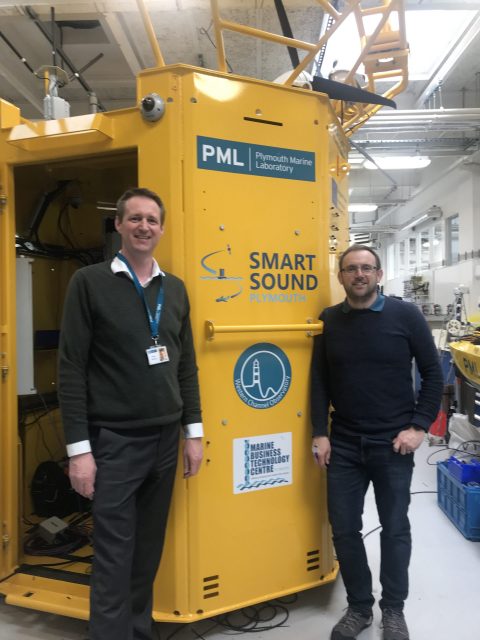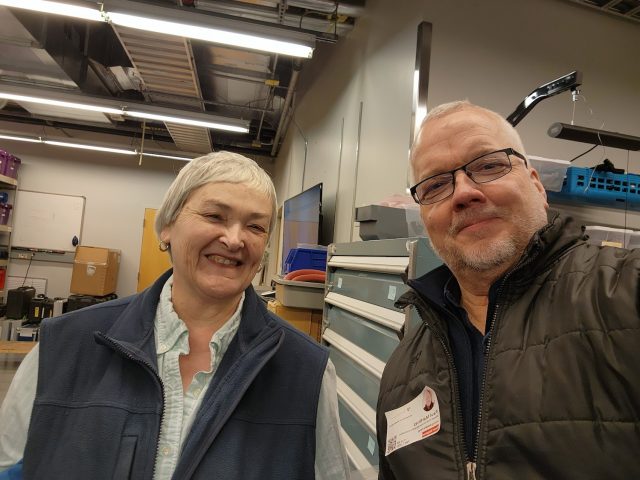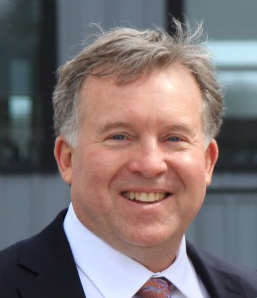Posts Tagged ‘Jim Edson’
Edson Represents OOI at POGO-26 Meeting in Malaysia
Jim Edson, Lead Principal Investigator of the NSF’s Ocean Observatories Initiative (OOI), recently attended the Partnership for Observation of the Global Ocean (POGO)-26 Meeting, held in Penang, Malaysia and hosted by the Centre for Marine and Coastal Studies (CEMACS). This international gathering brought together leading ocean researchers and policymakers to discuss issues and efforts in global ocean observation, capacity development, and outreach and advocacy.
The meeting covered a wide range of topics, including the role of blue carbon ecosystems in climate mitigation, biomolecular observations and environmental DNA (eDNA), sustainable ocean observation practices, digital twin technologies, marine heatwaves, and the far-reaching impacts of El Niño and La Niña on coastal and marine environments.
As part of the event, Edson participated in a panel discussion and delivered a presentation on the impact of El Niño and La Niña in the Northeast Pacific, drawing on a decade of Endurance Array data collected by OOI. His talk highlighted the importance of long-term oceanic datasets in understanding and predicting climate-driven changes in marine environments. The presentation sparked significant discussion among attendees, emphasizing the growing need for sustained ocean observations to improve forecasting, resource management, and climate resilience strategies.
Edson also provided an update on efforts to share metadata between the OOI and OceanSITES/OceanOPS. This effort will make the OOI surface mooring data more discoverable within this global network. This effort is led by the Coastal Global Scale Node (CGSN) team, which is conducting a pilot study using several methods to share the metadata. The OceanSITE component of this effort is supported by GOOS and represents a joint effort between the NSF, NOAA, POGO and GOOS.
By participating in POGO-26, Edson reinforced OOI’s role as a key contributor to global ocean monitoring efforts and OOI’s commitment to providing high-quality, long-term ocean data that can inform scientific research and decision-making worldwide.
[caption id="attachment_36143" align="alignnone" width="640"]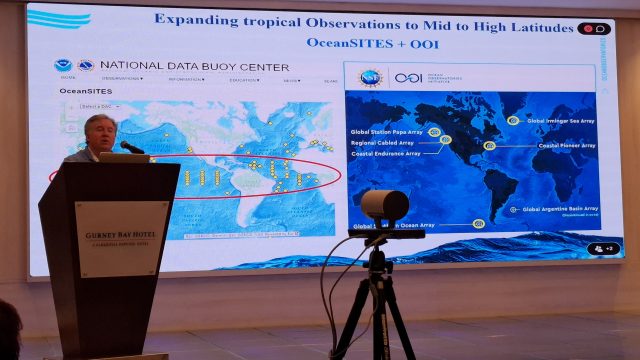 Jim Edson, OOI PI at presents at POGO-26[/caption]
[caption id="attachment_36144" align="alignnone" width="640"]
Jim Edson, OOI PI at presents at POGO-26[/caption]
[caption id="attachment_36144" align="alignnone" width="640"]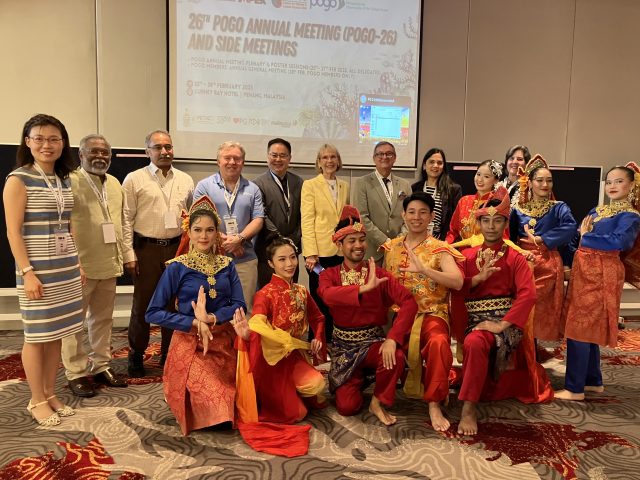 POGO-26 in Penang, Malaysia[/caption]
Read More
POGO-26 in Penang, Malaysia[/caption]
Read More Exploring Air-Sea Interactions at the AMS Annual Meeting
The Annual Meeting of the American Meteorological Society (AMS) is the largest national gathering for atmospheric scientists, drawing experts from various disciplines, including oceanography. This event serves as a key venue for advancing research and fostering collaborations across scientific communities.
AMS plays a critical role in disseminating oceanographic research through several journals, including the Bulletin of the AMS, Journal of Climate, Journal of Atmospheric and Oceanic Technology, and Journal of Physical Oceanography. These publications provide valuable platforms for cutting-edge studies in meteorology and oceanography.
A long-standing proponent of air-sea interaction research, the AMS supports this field through its dedicated Committee on Air-Sea Interaction. This committee organizes biennial research conferences at the annual meeting and frequently collaborates with other AMS committees to host joint sessions at these locations. Most recently, the Air-Sea Interaction Committee has expanded its collaborative efforts beyond AMS, partnering with the American Geophysical Union (AGU) to organize sessions at the Ocean Sciences Meeting.
At this year’s AMS Annual Meeting, the 24th Conference on Air-Sea Interaction was held in New Orleans, providing a platform for researchers to present their latest findings. James Edson, Principal Investigator of the Ocean Observatories Initiative (OOI), and Ben Barr, Postdoctoral Investigator at Woods Hole Oceanographic Institution (WHOI), along with their colleagues gave two presentations investigating air-sea interaction in high winds and extreme environments using OOI data. Their talks included:
- 10.2 Edson and Barr: Improvements to the COARE Bulk Flux Algorithm under Extreme Wind and Wave Conditions using NSF OOI Data
- 10.5 Barr, Seo, Edson, Sauvage, and Clayson: Understanding and Constraining Interfacial and Sea Spray Heat Fluxes in High Winds Using Direct Covariance Heat Flux Observations
These presentations were met with significant enthusiasm, sparking in-depth discussions that extended well into the lunch break. The engagement and interest generated by these talks reflect the growing importance of high-quality observational data in advancing our understanding of air-sea interactions, particularly under extreme environmental conditions.
As research on air-sea interactions advances, events like the AMS Annual Meeting play a crucial role in driving progress in marine meteorology. By leveraging innovative observational tools and fostering interdisciplinary collaboration, scientists are set to make significant strides in understanding the complex dynamics at the interface of the ocean and atmosphere.
Read MoreEdson Encourages Federal Agencies to Use OOI Data
The U.S. National Science Foundation Ocean Observatories Initiative (OOI) Program Management Office Principal Investigator Jim Edson was invited to Pasadena, CA in April to present to a group of 160+ of experts who use satellite data to study the planetary boundary layer (PBL) over land, sea, and ice. These experts use observations and modeling to determine the PBL and represented an alphabet soup of federal agencies – NASA, NOAA, CLIVAR, DOE, ONR and NCAR. Edson took the opportunity to introduce them to OOI.
The attendees came together for NASA’s Decadal Survey Planetary Boundary Layer Incubation Community Meeting. Edson gave a presentation about observing the marine PBL using OOI and its partnership with the National Data Buoy Center and OceanSITES as examples of how to build an ocean network of observations.
“This presentation was one of my ongoing efforts to share knowledge about OOI and the data it can deliver,” said Edson. “By focusing on how valuable and rich the available data are, I hoped to re-enforce to our colleagues at these various agencies and institutions that OOI data are an important source for satellite calibration and validation activities over the open ocean. This represents only one of multiple ways that OOI can be used to clarify our understanding of what is going on in the rapidly changing marine environment.”
Read MoreEdson Showcases OOI at COP 28
Ocean Observatories Initiative (OOI) Principal investigator Jim Edson spent a week in Dubai at COP 28 (28th meeting of the United Nations Climate Change Conference) as part of the contingent representing Woods Hole Oceanographic Institution (WHOI) at the Ocean Pavilion. While at the second Ocean Pavilion, co-hosted with Scripps Institution of Oceanography, Edson participated in a panel discussion on marine heat waves and a side event on the importance of ocean observing. When not presenting, Edson met with international colleagues and helped staff the booth, answering questions and engaging with an international audience interested in the ocean’s role in addressing climate change.
“COP28 was an amazing coming together of the international community to try to figure out a way to address the many pressing climate-related problems now being experienced all over the world. It provided a platform for island nations such as Tonga, which is losing its territory in real time to sea level rise to share real life examples of climate change happening now. It was sobering and serious work, and one where finally the important role of the ocean was recognized,” he said.
“It is important that OOI be visible on the world stage so all those who can use our data to advance knowledge are aware of its existence and encouraged to use to help find answers to their own research questions,” he added.
Edson was one of five presenters at a side event held at one of COP 28’s larger auditoriums. The side event was entitled Global Ocean Observations for Equitable Knowledge-based Decision-making and included panels on ocean observing and policy. He led off the ocean observing panel with a report on OOI and how its data are advancing understanding of the changing ocean, while stressing that purposeful observation, collaboration, capacity building and stakeholder engagement are critical to address the climate challenges effectively and equitably. Edson was joined by Kilaparti Ramakrishna, Director of Marine Policy Center and Senior Advisor to the President on Ocean and Climate Policy at WHOI; Carol Anne Clayson, Director of Research Strategies and Innovation at WHOI; Lynne Talley, Distinguished Professor of Oceanography at Scripps Institution of Oceanography; and Helen Findlay, Professor at the Plymouth Marine Laboratory. The ocean policy panel included Edward Hill, Chief Executive of the National Oceanography Centre (NOC); Paula Sierra-Correa, Co-Chair of the International Oceanographic Data and Information Exchange (IODE) 2023-2025 and Research and Information Coordinator; and Sophie Seeyave, CEO of the Partnership for Observation of the Global Ocean (POGO). The side event was recorded and can be watched here.
[media-caption path="https://oceanobservatories.org/wp-content/uploads/2024/01/Side-event.jpg" link="#"]The side event on importance of ocean observations participants (from left) Helen Findlay, Lynne Kelly, Kilaparti Ramakrishna, Carol Anne Clayson, and Jim Edson. The panel on ocean policy at the side event included Edward Hill, Paula Sierra-Correa and Sophie Seeyave. Credit: ©WHOI.[/media-caption]Edson also was a participant during a panel discussion at the Ocean Pavilion on marine heat waves: A Heated Case for Ocean Observations. Marine heatwaves are a significant ecological and socioeconomic threat, worldwide, and have been increasing in both duration and frequency, a trend that is likely to continue. This session focused on how sustained ocean observations can help understand and predict these phenomena so that mankind can prepare for, and mitigate, their effects.
Edson represented OOI on the panel and provided examples of how OOI data have been used to identify marine heat waves using presentations from Coastal and Global Scale Nodes Lead Scientist Al Plueddemann and Coastal Endurance Array Lead Scientist Ed Dever. Other panelists were Kelly Oskvig, Senior Program Officer, National Academies Sciences, Engineering, Medicine; Lynne Talley, Professor, Scripps Institution of Oceanography, UC San Diego; Sofia Darmaraki, Principal Investigator, Foundation for Research and Technology – Hellas, Greece; and Tammy Russell, PhD Student, Scripps Institution of Oceanography. Opening comments were provided by the Honorable Sheldon Whitehouse, US Senator from Rhode Island. The panel was recorded and can be watched here.
[media-caption path="https://oceanobservatories.org/wp-content/uploads/2024/01/Marine-heat-waves.jpg" link="#"]The panel on marine heat waves included (from left)Tammy Russell, Lynne Talley, US Senator Sheldon Whitehouse, Kelly Oskvig, and Jim Edson.Credit: ©WHOI.[/media-caption]
The importance of the ocean’s role in climate change and why it must be a key topic at COP28, and future discussions was captured in an editorial opinion piece written by Peter de Menocal, president and director of the Woods Hole Oceanographic Institution, and Margaret Leinen, vice chancellor for marine science and director of the Scripps Institution of Oceanography/University of California San Diego, co-sponsors of the COP28 Ocean Pavilion. They cite additional ocean observations as a vital component moving forward.
https://oceanographicmagazine.com/features/the-ocean-our-greatest-ally-in-tackling-climate-change/
Read More
Connecting with International Ocean Observing Networks
The Ocean Observatories Initiative (OOI) Program Management Office Principal Investigator Jim Edson is taking OOI data on the road to maximize use of OOI data and build partnerships, wherever feasible. “My intent in making presentations to ocean observing networks around the globe is to help spread the word about OOI so that users take full advantage of the wealth of data being collected.”
Since the beginning of the year, Edson has made presentations at annual meetings of the American Meteorological Society (AMS) in Denver and at the Partnership for Observation in the Global Ocean (POGO) in Toulon, France. In early March, he presented and led discussions at a US CLIVAR sponsored workshop in Boulder, before heading to the UK in late March to follow up on connections he made while representing OOI at COP 27.
AMS was a natural for Edson, a meteorologist, who has been an AMS fellow since 2020. He discussed with colleagues there, the many ways that OOI data are being used to constrain air-sea fluxes, including real-life examples of advances in the accuracy of surface fluxes and improved bulk parameterizations.
[media-caption path="https://oceanobservatories.org/wp-content/uploads/2023/04/Jim-and-team-at-PML-scaled.jpeg" link="#"]Tom Bell (left) and James Fishwick (right) gave Jim Edson (middle) a tour of the Plymouth Marine Laboratory facilities during Jim’s return visit there.[/media-caption]Next up was the annual meeting of POGO, where Edson represented both OOI and the Woods Hole Oceanographic Institution where Edson is a Senior Scientist. At POGO, Edson presented an overview of the surface variable, oceanographic, and biogeochemical data collected by the OOI arrays, which researchers are using to advance understanding of the changing ocean. He included examples of research being conducted at the global, coastal and regional arrays. For example, Edson provided a brief description of how OOI data are being used to improve the Coupled Ocean and Atmosphere Experiment (COARE) bulk flux algorithm using a growing global array of momentum and heat fluxes.
March started with another invited presentation to US Climate Variability and Predictability Program (CLIVAR). US CLIVAR is a national research program that fosters understanding and prediction of climate variability with an emphasis on the role of the ocean and its interaction with other elements of the Earth. While there, Edson presented possible OOI data contributions to ongoing modeling efforts. He also described how existing OOI infrastructure could be leveraged in upcoming US CLIVAR field programs.
[media-caption path="https://oceanobservatories.org/wp-content/uploads/2023/04/PML_Photo-2.jpg" link="#"]Gas Exchange Workshop Attendees at Imperial College in London.[/media-caption]Edson wrapped up his travels with a visit the United Kingdom to give OOI talks, engage with staff, and participate in tours of the facilities with colleagues from the National Oceanography Centre (NOC) in Southampton and the Plymouth Marine Laboratory (PML) in Plymouth. In between, he participated in a Gas Exchange Workshop at Imperial College in London where he described the CO2 and pH data being collected by OOI to his colleagues. He used these COP-27-inspired visits to build relationships and explore collaborations with international partners, with the goal of expanding use of OOI data in cutting-edge research and sharing lessons learned with these ocean-observing institutions.
“As a large facility funded by the NSF and an endorsed project of the UN Decade for Ocean Science and Sustainability, the OOI is perfectly positioned to make a difference by sharing our wealth of data to answer pressing issues about the state of the ocean,” said Edson. “I am committed to doing all that I can to help realized OOI’s maximum contribution during this critical time for our planet.”
Read More
Visit to West Coast OOI Facilities
A group of Ocean Observatories Initiative (OOI) leaders visited OOI facilities at Oregon State University and the University of Washington last week to get a first-hand look at operations of the Coastal Endurance Array and Regional Cabled Array, respectively. National Science Foundation Program Director George Voulgaris, OOI Principal Investigator Jim Edson and Senior Program Manager Paul Matthias spent five days on the road meeting with their OOI west coast colleagues. The trip was designed to give recently appointed Voulgaris an opportunity to inspect the infrastructure and meet team members who keep the Coastal Endurance and Regional Cabled Arrays operational and reporting back data around the clock. Edson and Matthias seized the opportunity to meet in person with colleagues who they routinely see on the screen.
The following provides a glimpse of some of the activities that occurred during the trip:
[media-caption path="https://oceanobservatories.org/wp-content/uploads/2023/02/20230207_140014.jpg" link="#"]Grant Dunn, Mechanical Engineer with the Electronic & Photonic Systems Department at UW-APL (left) describes the level-wind system on the RCA profiler mooring to Dr. George Voulgaris during a tour of the RCA laboratory facilities at the University of Washington as RCA Project Manager Brian Ittig looks on. Credit: Paul K. Matthias © WHOI.[/media-caption] [media-caption path="https://oceanobservatories.org/wp-content/uploads/2023/02/20230207_144911.jpg" link="#"]Regional Cabled Array Principal Investigator Deborah Kelley (left) and OOI Senior Program Manager Paul Matthias take a selfie to commemorate their in-person visit during a tour of the RCA facilities at the University of Washington. Credit: Paul K. Matthias © WHOI.[/media-caption] [media-caption path="https://oceanobservatories.org/wp-content/uploads/2023/02/20230207_141656.jpg" link="#"]NSF Program Director George Voulgaris (from left), OOI Principal Investigator Jim Edson look on as Regional Cabled Array technicians Grant Dunn, Mechanical Engineer with the Electronic & Photonic Systems Department at UW-APL, and RCA Chief Engineer Chuck McGuire explain the engineering associated with the RCA profiler mooring during a tour of RCA’s facilities at the University of Washington. Credit: Paul K. Matthias © WHOI.[/media-caption] [media-caption path="https://oceanobservatories.org/wp-content/uploads/2023/02/20230209_123758.jpg" link="#"]NSF Program Director George Voulgaris (left) asks OSU technician Jonathan Whitefield questions about glider operations that provide critical water column data around the moorings of the Coastal Endurance Array. Credit: Paul K. Matthias © WHOI.[/media-caption] [media-caption path="https://oceanobservatories.org/wp-content/uploads/2023/02/20230207_112718.jpg" link="#"]NSF Program Director George Voulgaris (foreground) and RCA Chief Engineer Chuck McGuire discuss the RCA data monitoring systems as OOI PI Jim Edson points to real-time data on the screen being relayed by instrumentation on the Regional Cabled Array. Credit: Paul K. Matthias © WHOI.[/media-caption] [media-caption path="https://oceanobservatories.org/wp-content/uploads/2023/02/20230209_130353.jpg" link="#"]NSF Program Director George Voulgaris (left) gets a hands-on look at the multiple instruments contained on multi-function node that will sit on the bottom of the ocean floor for six months collecting data for the Coastal Endurance Array. Coastal Endurance Array Principal Investigator Ed Dever (middle) and Project Manager Jonathan Fram the functionality of each instrument during the visit to Oregon State University. Credit: Paul K. Matthias © WHOI.[/media-caption]
Read More
WHOI’s Jim Edson to Replace John Trowbridge as OOI’s Principal Investigator
The National Science Foundation has approved the appointment of Dr. James B. Edson as the new Principal Investigator (PI) of the Ocean Observatories Initiative (OOI) Program Management Office (PMO). Edson will assume his responsibilities on March 1, taking over for Dr. John Trowbridge, who announced his intention to leave for a new position in January and has led the PMO from October 2018, when the program management office was moved to the Woods Hole Oceanographic Institution (WHOI) from the Consortium for Ocean Leadership (COL) in Washington, D.C.
“John’s done an exceptional job leading OOI and leaves very big shoes to fill, and we are delighted to have Jim assume the reins and are confident in his ability to lead OOI through the leadership transition and beyond” said Rick Murray, WHOI Deputy Director and Vice President for Science and Engineering, who led the search for Trowbridge’s replacement. “Jim has a phenomenal depth of knowledge about OOI’s early years, having served [with Trowbridge] on the ORION Science & Technology Advisory Committee during the OOI planning stages and as a member and chair of the OOI Program Advisory Committee from 2008-2013. Plus, Jim brings a wealth of experience running large government programs and academic departments. We share his excitement in leading OOI.”
Edson was an Assistant through Associate Scientist with tenure in the Department of Applied Ocean Physics and Engineering at WHOI from 1991 to 2004. He also served as a rotator at the Office of Naval Research from 1998-1999. His research interests include boundary-layer meteorology, with a focus on surface-layer turbulence, air-sea interaction and flux parameterizations. During this period, Edson was Chief Scientist for the Office of Naval Research Coupled Boundary Layers and Air-Sea Transfer (CBLAST) Defense Research Initiative, and Principal Investigator for the Construction and Management of the Martha’s Vineyard Coastal Observatory and its Air-Sea Interaction Tower at WHOI. Edson was Professor and Head of Marine Sciences at the University of Connecticut (UConn) from 2005 to 2017, where he led UConn’s successful effort to join the University Corporation for Atmospheric Research, served as UConn’s member representative for the COL, and oversaw the upgrade and stretch of the R/V Connecticut. He rejoined WHOI in 2018 as a Senior Scientist.
Edson is a fellow of the American Meteorological Society and member of the American Geophysical Union. He has written more than 80 scientific articles and has contributed to 18 scientific books. Edson received a PhD in meteorology from the Pennsylvania State University.
Edson assumes the leadership of an organization that is in excellent shape due to Trowbridge’s leadership. Among many innovations during his tenure, Trowbridge oversaw the development and launch of a new data delivery system, Data Explorer, and the transition of the cyberinfrastructure network to a new state-of-the-art data center at Oregon State University. Despite challenges imposed by costs to upgrade cyberinfrastructure, a flat budget, and Covid-19, Trowbridge ensured that the program accomplished the full scope of marine operations while staying within budget. Trowbridge enabled a highly motivated and capable team, established productive relationships within the Program and with NSF and the Ocean Observatories Initiative Facilities Board, and led a robust community engagement effort.
To ensure a smooth transition, Trowbridge will end his service as the OOI PI on March 1, but will continue half-time to support Edson during a four-month transition period. On June 30, Edson will begin his tenure as the full-time OOI PI.
The Ocean Observatories Initiative is a long-term infrastructure project funded by the National Science Foundation to gather physical, chemical, and biological data from the ocean, atmosphere, and seafloor and to deliver that data on demand and in near real-time online. The program includes moored instrument arrays and autonomous underwater vehicles deployed at critical locations in the coastal and open ocean worldwide. Data from the observatories help researchers address questions across short and long time periods, small and large spatial scales, and from the ocean surface to the seafloor. OOI is managed by the Woods Hole Oceanographic Institution (WHOI) and implemented by WHOI, the University of Washington, and Oregon State University.
Read More
